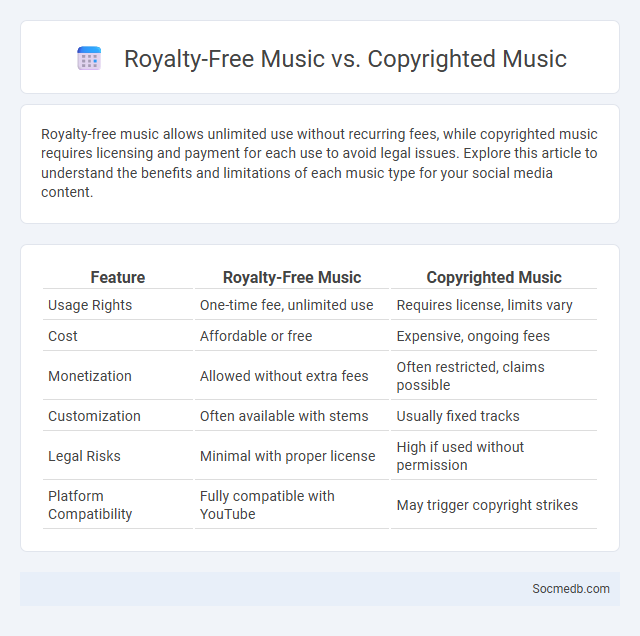
Photo illustration: Royalty-Free Music vs Copyrighted Music
Royalty-free music allows unlimited use without recurring fees, while copyrighted music requires licensing and payment for each use to avoid legal issues. Explore this article to understand the benefits and limitations of each music type for your social media content.
Table of Comparison
| Feature | Royalty-Free Music | Copyrighted Music |
|---|---|---|
| Usage Rights | One-time fee, unlimited use | Requires license, limits vary |
| Cost | Affordable or free | Expensive, ongoing fees |
| Monetization | Allowed without extra fees | Often restricted, claims possible |
| Customization | Often available with stems | Usually fixed tracks |
| Legal Risks | Minimal with proper license | High if used without permission |
| Platform Compatibility | Fully compatible with YouTube | May trigger copyright strikes |
Understanding Royalty-Free Music
Royalty-free music allows social media content creators to use tracks without paying ongoing fees, simplifying copyright compliance and reducing legal risks. Platforms like YouTube and Instagram prioritize content with licensed or royalty-free audio to avoid demonetization or removal. Understanding the terms of royalty-free licenses ensures creators can legally enhance videos with music while maintaining monetization and audience engagement.
What is Copyrighted Music?
Copyrighted music refers to musical compositions, sound recordings, and lyrics that are legally protected under copyright law, granting the creator exclusive rights to use, distribute, and license their work. On social media platforms, using copyrighted music without permission can lead to content removal, account suspension, or legal consequences due to strict enforcement by rights holders and automated detection systems. Proper licensing or use of royalty-free music ensures compliance and avoids infringement issues in digital content sharing.
The Basics of Copyright Claims
Copyright claims on social media protect original content creators by enforcing exclusive rights to their work, including photos, videos, and written posts. Platforms like Instagram, Facebook, and YouTube use automated systems such as Content ID and Rights Manager to detect unauthorized use and manage takedown notices or monetization rights. Understanding fair use, transformative content, and the Digital Millennium Copyright Act (DMCA) helps users navigate and respond to copyright claims effectively.
Key Differences: Royalty-Free vs Copyrighted Music
Royalty-free music allows you to use tracks without ongoing fees, offering flexibility for various social media projects while maintaining legal clarity. Copyrighted music requires permission and often payment to avoid infringement claims, limiting its use in videos or streams on platforms like Instagram and YouTube. Understanding these distinctions helps protect your content from takedowns and monetization issues on social media channels.
Licensing Agreements Explained
Licensing agreements in social media define the terms under which users grant platforms permission to use, distribute, or modify their content, ensuring clarity around intellectual property rights. These agreements often cover rights for content reproduction, display, and monetization, protecting both creators and social media companies. Understanding licensing terms helps users control their content's usage while enabling platforms to legally feature user-generated material.
Common Misconceptions About Music Rights
Many users mistakenly believe that sharing music on social media platforms is free from copyright restrictions, leading to unauthorized use of protected songs. Copyright law grants exclusive rights to artists and record labels, meaning any public use without permission can result in legal consequences. Understanding the intricacies of music licensing and the role of digital rights management is essential to avoid infringement penalties.
Benefits of Using Royalty-Free Music
Using royalty-free music in social media content enhances engagement by providing high-quality audio without copyright restrictions, ensuring videos remain monetizable and shareable across platforms like YouTube, Instagram, and TikTok. This approach significantly reduces legal risks and streamlines content production costs, as creators avoid expensive licensing fees and potential takedown notices. High-quality royalty-free tracks also improve viewer experience, boosting brand reputation and fostering a loyal online community through consistent and professional-sounding media.
Legal Risks with Copyrighted Music
Using copyrighted music on social media platforms exposes users to significant legal risks, including copyright infringement claims and potential financial penalties. Platforms like YouTube, Instagram, and TikTok enforce strict copyright policies through automated Content ID and Digital Millennium Copyright Act (DMCA) takedown notices. To mitigate these risks, users should utilize royalty-free music libraries or obtain proper licenses from rights holders before posting content featuring copyrighted tracks.
How Copyright Claims Affect Content Creators
Copyright claims significantly impact content creators by limiting their ability to monetize and share original work freely on social media platforms. Your content may be demonetized, removed, or receive restrictions, reducing visibility and engagement with your audience. Understanding the nuances of copyright laws and platform policies helps protect your creations and maintain control over your digital presence.
Choosing the Right Music for Your Project
Selecting the right music for your social media project enhances audience engagement and reinforces your brand identity. Consider the mood, tempo, and genre that align with your content's message and target audience preferences. Utilize royalty-free or licensed tracks from platforms like Epidemic Sound or Artlist to ensure legal compliance and high-quality sound.
 socmedb.com
socmedb.com